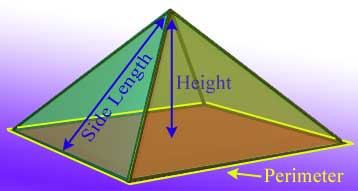Math Is Fun Forum
You are not logged in.
- Topics: Active | Unanswered
Pages: 1
#1 2010-02-07 01:10:01
- TurbanTore
- Member
- Registered: 2010-02-07
- Posts: 3
Cheops pyramid
Hello!
I need some help with some calculations on the Cheops pyramid. I'm trying to determinate the area that the casing stones used to cover and also the casing stones average size if I've been told the number of casing stones.
Each of the sides in the base is 230 meters and the height of the pyramid used to be approximately 146,5 meters. I thought that the area the casing stones used to cover (on one of the four sides) would be:
(230,0m*146,5m)/2 = 16772,6m2
But today I came to think of another way, where I use the length of one of the slanting sides (185,9m):
(230,0m*185,9m)/2 = 21376,9m2
If I then want to find out the average size of the casing stones I would think I could use one of the following equation:
Qx = 16772,6m2
Qx = 21376,9m2
Q stands for quantity of casing stones (Q is given) and x will tell what the average size of the casing stones in m2.
Which of the equations should I use?
Last edited by TurbanTore (2010-02-07 01:10:41)
Offline
#2 2010-02-07 01:24:18
- bobbym
- bumpkin

- From: Bumpkinland
- Registered: 2009-04-12
- Posts: 109,606
Re: Cheops pyramid
Hi;
The pyramids at Giza are square pyramids.
The casing stones as I understand them were limestone and were for cosmetic purposes, they lined the sides.

1/2 × Perimeter × [Side Length] + [Base Area]
We can leave out the base area to get the lateral area ( the sides).
lateral area = 1/2 × Perimeter × [Side Length]
This appears to be all four sides so we can multiply this by 1 / 4
1) Area of one side = 1/8 × Perimeter × [Side Length]
How does your measurements relate to the top drawing? If your slanting side length corresponds to the drawings "Side Length" then you would use formula 1 to get the area of one side.
In mathematics, you don't understand things. You just get used to them.
If it ain't broke, fix it until it is.
Always satisfy the Prime Directive of getting the right answer above all else.
Offline
#3 2010-02-07 01:57:55
- TurbanTore
- Member
- Registered: 2010-02-07
- Posts: 3
Re: Cheops pyramid
Thanks!
With your formula I got:
(920m*185,9m)/8 = 21378,5m,
this is the same answer that I got from (230m*185,9m)/2
Offline
#4 2010-02-07 02:15:55
- bobbym
- bumpkin

- From: Bumpkinland
- Registered: 2009-04-12
- Posts: 109,606
Re: Cheops pyramid
Hi TurbanTore;
Welcome to the forum. Come back and tell me what you are doing with the great pyramid. I am a big fan of all strange pyramid theories and have done some research of my own.
In mathematics, you don't understand things. You just get used to them.
If it ain't broke, fix it until it is.
Always satisfy the Prime Directive of getting the right answer above all else.
Offline
#5 2010-02-07 04:26:36
- TurbanTore
- Member
- Registered: 2010-02-07
- Posts: 3
Re: Cheops pyramid
If you're interested in strange pyramid theories you might have heard that some people think that the pyramid of Cheops was covered with exactly 144 000 white casing stones. The number 144 000 is supposedly a much used number in the Bible and ancient constructions around the world. I personally do NOT believe in such alternate history and therefore I wanted to check the numbers for myself. If the pyramid exactly had 144 000 casing stones, then on each side it would have had to be 36 000 stones.
Then if i write the equation 36000x = 21376,9m2 I'll get that the average size of each casing stone would have been approximately 0.60 m2.
At first I thought that I could just calculate the area of a regular triangle and when I did that I got that the average area of each brick would had to be 0.46m2. As you possibly know, the pyramid of Cheops has lost almost all of its casing stones, but one record by Howard Vyse (from the 1800s) states that one casing stone was 1.5m*1m. We also know that the casing stones at the bottom of the Pyramid of Cheops (some of them are still preserved) was fairly large and therefore the casing stones on the top of the pyramid must have been pretty small so that average size of the casing stones would end at 0.46m2, maybe as small as bricks. The Pyramid of Khafre still has some of the casing stones on the top and they are fairly large (at least larger than bricks). Unfortunately my calculations were wrong and the average size of each brick seems to have been approximately 0.60m2, therefore the casing stones on the top could have been fairly larger than what they could have been with my first calculation. If my new calculations are correct and with the sources and pictures I have at my disposal, I unfortunately can't disprove the 144 000-theory.
There are of course no credible sources that supports the theory of the supposedly 144 000 casing stones, but I can't find sources that disproves the theory ether.
Offline
#6 2010-02-07 13:38:02
- bobbym
- bumpkin

- From: Bumpkinland
- Registered: 2009-04-12
- Posts: 109,606
Re: Cheops pyramid
Hi;
I knew about the casing stones but you have told me something I did not know. Thanks for the information.
I personally do NOT believe in such alternate history
That's funny, I do.
In mathematics, you don't understand things. You just get used to them.
If it ain't broke, fix it until it is.
Always satisfy the Prime Directive of getting the right answer above all else.
Offline
Pages: 1